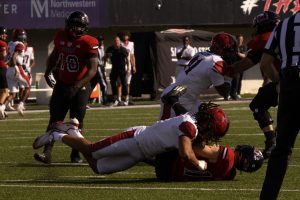Independents face changes
September 12, 1990
The Leftover League? The Casserole Conference? How about the Oddball Association?
By the end of the decade or sooner, if Division I football independents aren’t invited to join either an existing conference or a newly-formed mutant group, they could form one of their own, say independent athletic directors.
Of this year’s 25 independents, one (Penn State) has accepted the Big Ten’s engagement ring and for six Eastern schools (Boston College, Pitt, Syracuse, Temple, Rutgers and West Virginia) the question is not if, but when.
Miami and Florida State are prize Atlantic catches for some coastal alliance. Notre Dame, with its rebellious TV package, can stay independent, but “They’re in another world,” Louisiana Tech AD Paul Miller says.
In the next few years, the remaining 15 misfits, NIU included, will most likely align with a league, probably their own. Being swallowed by any of the proposed gigantic elite conferences for schools like Tulane and Virginia Tech could literally be a no-win situation.
“If coaches have a say, they’re not gonna be too happy with a superconference because 50 percent of them are going to lose most of their games,” says University of Akron AD Jim Dennison.
“I think our greatest opportunity is going to be part of a new conference,” says NIU Athletic Director Gerald O’Dell. “I know we’re not ready to step up to the Big Ten or the Big Eight. I do think we offer the (TV) market but we don’t offer the facilities.”
O’Dell says in order to fulfill NIU’s goal of Division I-A conference affiliation, the school needs to improve its athletic facilities, strengthen its football schedule and increase outside funding.
For example, O’Dell says the independents with whom NIU would be most conference-compatible—Louisville, Akron, Louisiana Tech, Southwestern Louisiana, Cincinnati, Tulsa and Southern Mississippi—either have large stadiums or are planning to expand.
“People don’t want to come play at a second-rate facility. Secondly, it’s hard to recruit to a facility that’s not top quality,” says O’Dell.
To those who thought 25-year-old Huskie Stadium was the Taj Mahal of multi-use athletic structures, O’Dell says there’s not enough room for the number of athletes and coaches (football, field hockey, soccer, women’s gymnastics) who call the stadium home.
“We have approximately 125 football players and we have a training room which might accomodate soccer, field hockey and softball. That’s about it,” says O’Dell.
Only the football team has its own locker room. The women’s gymnastics team changes in a handicapped restroom.
“It’s really a Division II facility and that’s what it was built for. It was built to accomodate a college division, as it was called then, or a Division II athletic program,” O’Dell says.
NIU’s football schedule, tentative through 2000, reflects the school’s wish to build a reputation. Driven by one part ambition, one part NCAA legislation, NIU has scheduled fewer Division I-AA squads (just one in 1992 and 1993). The NCAA announced recently that beginning in 1991 a team must have beaten at least six Division I teams to be bowl-worthy.
Future opponents include Illinois, Arkansas, Army, Iowa, Florida, Indiana and Wisconsin.
Scheduling is very much on athletic directors’ minds when the subject of conference realignment is brought up. The bigger the leagues, the fewer open dates the newly aligned teams will offer. Even now, says Louisiana Tech’s Miller, “Scheduling as an independent is horrendous.”
Akron’s Dennison says what “scares me more than anything” is the prospect of firmly scheduled independents joining a league before the end of the teams’ scheduling contract. Usually such problems are settled by what O’Dell calls “gentlemen’s agreements”, but schools can and have broken contracts resulting in losses of money and additions of hassle. Legal action is usually only brought on by short-notice pull-outs.
If a team chooses not to buy out of a contract and simply pull out, it can be sued. Dennison says such cases “haven’t held up well in courts.”
NIU Legal Counsel George Shur says the contracts are legally binding, the problem with them depends on the schools involved. If two state schools are involved in a suit, the court of jurisdiction is the United States Supreme Court. Shur says no one wants to go that far. Out-of-court settlements are the result.
“Whatever configuration comes out of all this conference affiliation talk, there’s gonna be changes made,” says O’Dell. “These things (schedule changes) go back and forth, it’s part of the games you play. I don’t think anything’s ever written in stone, even these contracts.”
O’Dell says deals have been made between NIU and others in the past few years. O’Dell felt NIU was in over its head in 1988 and pulled NIU out of a game, at some cost, with national power Florida State.
O’Dell also points out that as independents disappear, teams like Central Florida, Georgia Southern and Arkansas State will soon be granted Division I status.
As usual, the whims of the greedy will shake up the comfort of the content. Athletic director’s feelings range from the fear of the unknown—”It could get to be an emergency overnight,” says Dennison—to O’Dell’s calmness borne of conviction. By 1993, O’Dell says NIU’s schedule and facilities should be ready for the big time.
“I don’t think we should be in a panic situation,” says O’Dell. “We have to worry about what we have to do to be in position when the opportunity comes for a I-A conference affiliation. You need to be attractive when the date is offered.”






